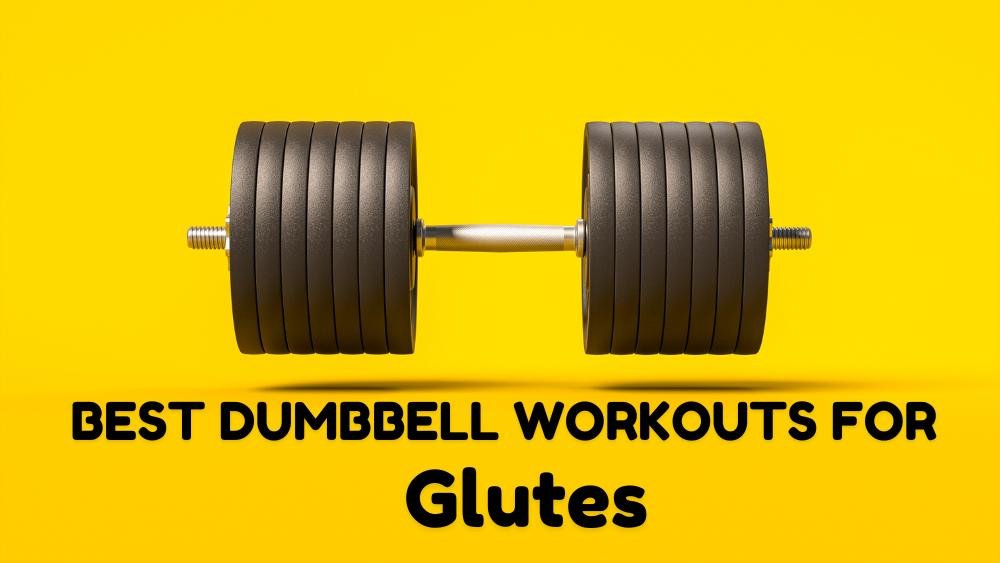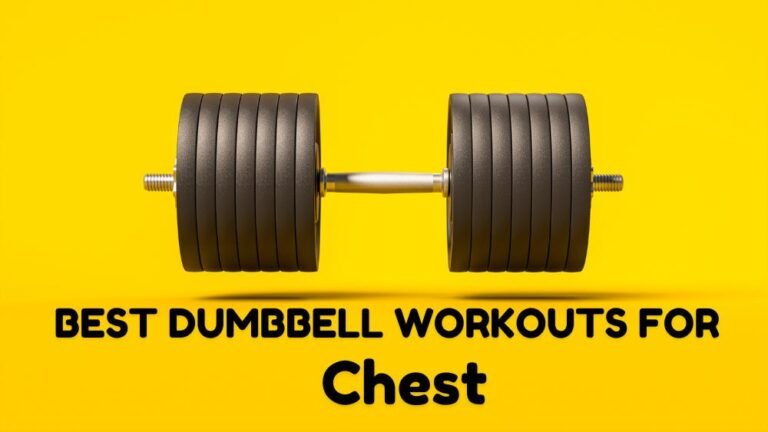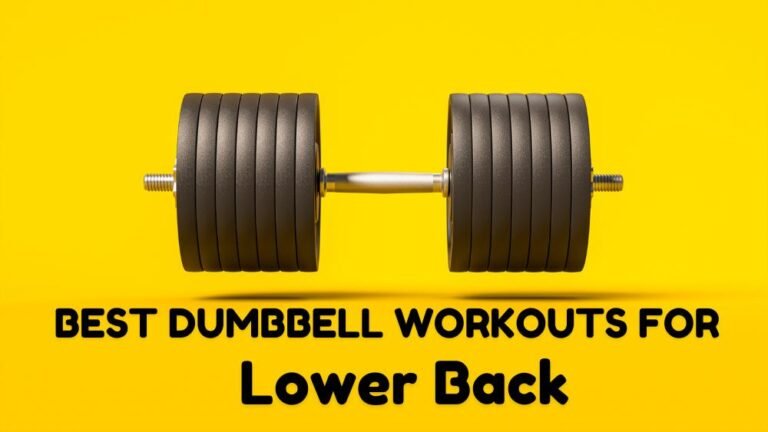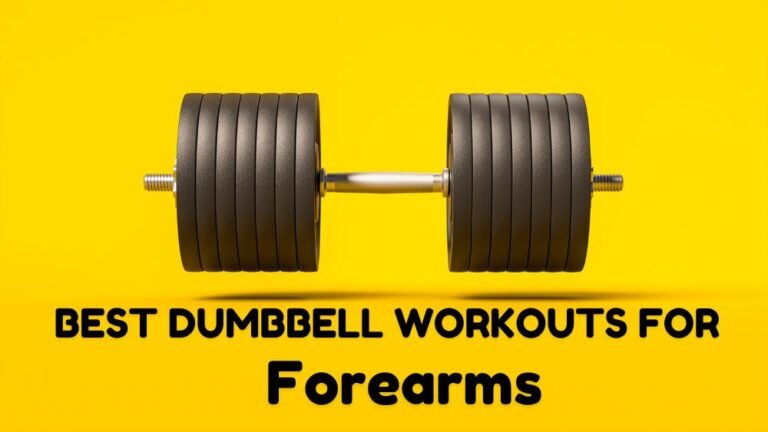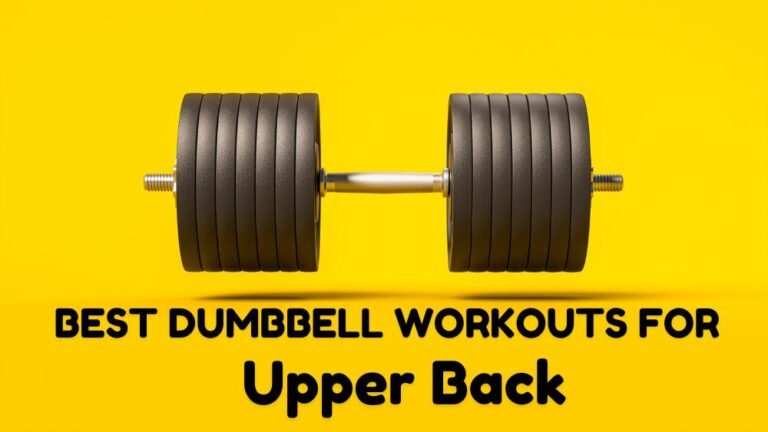14 Best Dumbbell Exercises to Sculpt Your Glutes
When it comes to achieving a toned and strong lower body, targeting the glutes is essential. Many fitness enthusiasts are on the lookout for effective ways to enhance their glute muscles, and incorporating dumbbell exercises into their routine can yield impressive results.
Whether you’re a beginner or an experienced lifter, understanding the benefits of using dumbbells can elevate your workouts and help you achieve your fitness goals.
In this article, we’ll explore the advantages of dumbbell exercises specifically designed for the glutes, setting the stage for a stronger, more sculpted physique.
Best Glutes exercises with dumbbell
When it comes to enhancing your glute muscles, incorporating dumbbells into your workout routine can be highly effective. These versatile weights allow for a variety of movements that target not only the glutes but also engage the core and lower body.
By focusing on controlled movements and proper form, you can increase muscle activation and build strength. Whether you’re aiming for hypertrophy or endurance, integrating dumbbell exercises can lead to balanced development and improved overall performance.
Remember to progressively increase the weight and vary your routines to keep challenging your muscles and achieving ideal results.
Dumbbell Glute Bridge
The Dumbbell Glute Bridge is a highly effective exercise for targeting the glute muscles, particularly the gluteus maximus. This compound movement not only enhances muscle strength but also improves overall hip stability and flexibility.
By incorporating a dumbbell into the exercise, you increase the resistance, which can lead to greater muscle activation and development. It’s an excellent choice for those looking to build stronger, more defined glutes, and can be easily modified for different fitness levels.
To execute the Dumbbell Glute Bridge correctly, follow these steps:
- Start by lying on your back on a flat surface, with your knees bent and feet flat on the ground, hip-width apart.
- Place a dumbbell across your hips, holding it securely with both hands.
- Engage your core, then push through your heels to lift your hips towards the ceiling, squeezing your glutes at the top of the movement.
- Hold the bridge position for a moment, ensuring your body forms a straight line from your shoulders to your knees.
- Slowly lower your hips back down to the starting position while maintaining control.
Dumbbell Step-Up
The Dumbbell Step-Up is an effective exercise for targeting the glutes, as well as engaging the quadriceps and hamstrings. This functional movement mimics everyday activities such as climbing stairs, making it not only beneficial for building strength but also for improving overall stability and balance.
Incorporating dumbbells adds resistance, intensifying the workout and promoting muscle growth in the gluteal area. By performing step-ups with proper form, you can enhance your lower body strength while also boosting your core stability.
To execute the Dumbbell Step-Up correctly, follow these steps:
- Stand facing a sturdy bench or step with a dumbbell in each hand, arms relaxed at your sides.
- Position your feet hip-width apart and guarantee your core is engaged.
- Step forward with one foot, placing it firmly on the bench or step, and push through your heel to lift your body upward.
- Bring your other foot up to the bench, standing tall at the top of the movement.
- Slowly lower your trailing foot back to the ground, following with your leading foot to return to the starting position.
Dumbbell Hip Thrust
The dumbbell hip thrust is an effective exercise designed to target the glute muscles, particularly the gluteus maximus. This movement is essential for building strength and size in the glutes while also enhancing overall hip stability.
By incorporating a dumbbell into the hip thrust, you can increase the resistance and challenge your muscles even further. The exercise can be performed anywhere with minimal equipment, making it a versatile addition to any workout routine.
To execute the dumbbell hip thrust correctly, follow these steps:
- Sit on the ground with your upper back against a bench or elevated surface, with your feet flat on the floor, hip-width apart.
- Roll a dumbbell over your hips and hold it in place with both hands.
- Drive through your heels and lift your hips towards the ceiling, squeezing your glutes at the top of the movement.
- Pause briefly at the top, ensuring your body forms a straight line from your shoulders to your knees.
Dumbbell Frog Pump
The Dumbbell Frog Pump is a highly effective exercise designed to target the glute muscles, specifically the gluteus maximus, by engaging them in a unique position that maximizes contraction. This exercise not only helps in building strength but also promotes flexibility in the hip joints.
By incorporating dumbbells into the movement, you can add extra resistance, which further enhances muscle activation and growth. The frog pump is particularly beneficial for those looking to sculpt and tone their glutes while also improving overall lower body strength.
To execute the Dumbbell Frog Pump properly, follow these steps:
- Begin by lying on your back on a mat or flat surface, with your knees bent and the soles of your feet touching each other to form a diamond shape.
- Hold a dumbbell with both hands and place it on your hips for added resistance.
- Engage your core and push through your heels to lift your hips off the ground, squeezing your glutes at the top of the movement.
- Hold the peak of the contraction for a moment before lowering your hips back down to the starting position.
Dumbbell Fire Hydrant
The Dumbbell Fire Hydrant is an excellent exercise for targeting the gluteus medius and maximus, promoting strength and stability in the hips. This movement mimics the action of a dog lifting its leg to mark territory, hence the name.
By incorporating a dumbbell, you can increase the resistance, making the exercise more challenging and effective for building muscle and toning the glutes. Regularly performing Dumbbell Fire Hydrants can lead to improved hip mobility, better posture, and enhanced overall lower body strength.
To execute the Dumbbell Fire Hydrant correctly, follow these steps:
- Start on all fours with your hands directly under your shoulders and knees under your hips.
- Hold a light dumbbell in your right knee, ensuring your knee is bent at a 90-degree angle.
- Keeping your core engaged, lift your right leg out to the side, keeping your knee bent and hip stable.
- Squeeze your glute at the top of the movement, then lower your leg back to the starting position.
Dumbbell Glute March
The Dumbbell Glute March is an effective exercise for targeting the glute muscles while also engaging the core and improving balance. This exercise can be performed with a dumbbell in each hand, which adds resistance and intensifies the workout.
It’s particularly beneficial for those looking to enhance their glute strength and stability, making it a great addition to any lower body routine. Additionally, the Dumbbell Glute March can help improve your overall functional strength, which is essential for activities like running and jumping.
To execute the Dumbbell Glute March correctly, follow these steps:
- Begin by standing upright with a dumbbell in each hand, arms relaxed at your sides.
- Engage your core and maintain a straight posture throughout the movement.
- Lift your right knee towards your chest while simultaneously driving your left arm forward, mimicking a marching motion.
- Lower your right foot back to the ground and repeat the movement with your left leg, lifting the left knee and driving your right arm forward.
Dumbbell Romanian Deadlift
The Dumbbell Romanian Deadlift is an effective exercise for targeting the glutes, hamstrings, and lower back. This movement is highly regarded for its ability to isolate the posterior chain while also improving overall strength and stability.
By incorporating dumbbells, you can enhance your grip strength and engage your core more effectively. This exercise is particularly beneficial for individuals looking to build muscle mass and improve their athletic performance, as it mimics the hip hinge motion found in various sports and daily activities.
To execute the Dumbbell Romanian Deadlift properly, follow these steps:
- Stand with your feet hip-width apart, holding a dumbbell in each hand with an overhand grip.
- Keep your shoulders back and engage your core while maintaining a slight bend in your knees.
- Hinge at your hips, lowering the dumbbells along your shins while keeping your back straight and chest lifted.
- Lower the weights until you feel a stretch in your hamstrings, ensuring your hips move backward rather than down.
Dumbbell Bulgarian Split Squat
The Dumbbell Bulgarian Split Squat is an effective exercise targeting the glutes while also engaging the quads and hamstrings. This unilateral movement helps to improve balance and stability, making it a great addition to any lower body workout routine.
By elevating one foot behind you on a bench or platform, you create a deeper range of motion that emphasizes the glute muscles, leading to enhanced strength and muscle growth. Incorporating dumbbells into this exercise allows for increased resistance, challenging the muscles further and promoting greater gains.
To execute the Dumbbell Bulgarian Split Squat, follow these steps:
- Stand a few feet in front of a bench or elevated surface with a dumbbell in each hand, arms at your sides.
- Place one foot behind you on the bench or platform, making sure your toe is resting on the surface.
- Lower your body into a squat by bending your front knee, keeping your chest up and back straight, until your thigh is parallel to the ground.
- Push through your front heel to return to the starting position, fully extending your leg.
Dumbbell Goblet Squat
The Dumbbell Goblet Squat is an excellent exercise for targeting the glute muscles while also engaging the legs and core.
It’s particularly effective because it helps to improve squat form and provides a greater range of motion compared to traditional squats. By holding a dumbbell close to your chest, you can maintain an upright torso, which is essential for proper alignment and maximizing glute activation.
This exercise not only builds strength but also enhances stability and coordination.
To execute the Dumbbell Goblet Squat correctly, follow these steps:
- Start by standing with your feet shoulder-width apart, holding a dumbbell vertically with both hands at chest level.
- Keep your elbows pointed down and close to your body, ensuring the dumbbell is secure.
- Engage your core and, as you begin the squat, push your hips back and bend your knees to lower your body.
- Keep your chest up and back straight as you descend, aiming to get your thighs parallel to the ground or lower.
Dumbbell Single-Leg Deadlift
The Dumbbell Single-Leg Deadlift is an exceptional exercise for targeting the glute muscles while also enhancing balance and stability. This movement isolates each leg, ensuring symmetrical development and engagement of the glutes, hamstrings, and lower back.
By focusing on one leg at a time, it helps to correct muscle imbalances and increases core strength, making it an effective addition to any lower body workout routine.
To execute the Dumbbell Single-Leg Deadlift, follow these steps:
- Stand upright while holding a dumbbell in one hand, with your opposite arm resting by your side.
- Shift your weight onto the leg opposite to the hand holding the dumbbell.
- Keeping a slight bend in your standing leg, hinge at the hips and extend the free leg straight back, lowering the dumbbell toward the ground.
- Maintain a flat back and engage your core as you lower the dumbbell, ensuring your hips remain square to the ground.
- Return to the starting position by driving through the heel of the standing leg, engaging your glutes as you rise back up.
Dumbbell Walking Lunge
The Dumbbell Walking Lunge is an excellent exercise for targeting the glutes while also engaging the quadriceps and hamstrings. This dynamic movement not only enhances lower body strength but also improves balance and coordination.
Incorporating dumbbells adds resistance, increasing the effectiveness of the workout by challenging your muscles more than bodyweight lunges alone. By performing walking lunges, you can effectively sculpt and strengthen your glutes, making it a staple in any lower body routine.
To execute the Dumbbell Walking Lunge correctly, follow these steps:
- Stand upright with a dumbbell in each hand, arms at your sides.
- Step forward with your right leg, lowering your body until your right thigh is parallel to the ground and your left knee nearly touches the floor.
- Push through your right heel to return to the starting position.
- Repeat the movement by stepping forward with your left leg and lowering your body into the lunge.
Dumbbell Sumo Squat
The Dumbbell Sumo Squat is an excellent exercise specifically designed to target your glutes while also engaging your inner thighs and quadriceps. This variation of the traditional squat involves a wider stance, which shifts the emphasis to the gluteus maximus and helps in building strength and definition in this area.
By incorporating a dumbbell, you add resistance, which can enhance muscle activation and promote greater gains in strength and size over time. This exercise is ideal for those looking to sculpt their lower body and improve overall stability and mobility.
To execute the Dumbbell Sumo Squat effectively, follow these steps:
- Stand with your feet wider than shoulder-width apart, toes pointed outwards at about a 45-degree angle.
- Hold a dumbbell with both hands, letting it hang vertically between your legs.
- Engage your core, keeping your back straight and chest lifted.
- Begin the squat by bending at your hips and knees, lowering your body towards the ground while keeping the dumbbell close to your body.
- Go as low as you can while maintaining proper form, ideally until your thighs are parallel to the ground.
- Push through your heels to return to the starting position, squeezing your glutes at the top of the movement.
Dumbbell Lateral Lunge
The Dumbbell Lateral Lunge is an excellent exercise for targeting the glutes while also engaging the quadriceps and hamstrings. This movement emphasizes the outer hip muscles, promoting stability and strength in the lower body.
By incorporating a dumbbell, you can increase the resistance, making it more challenging and effective for muscle growth and endurance. Additionally, this exercise helps improve flexibility in the hips and enhances overall athletic performance, making it a valuable addition to your workout routine.
To execute the Dumbbell Lateral Lunge correctly, follow these steps:
- Stand with your feet hip-width apart, holding a dumbbell in each hand at your sides.
- Step out to the right with your right foot, bending your right knee while keeping your left leg straight.
- Push your hips back and lower your body until your right thigh is parallel to the ground, ensuring your right knee stays in line with your toes.
- Keep your chest up and core engaged throughout the movement.
Dumbbell Curtsy Lunge
The Dumbbell Curtsy Lunge is an excellent exercise for targeting the glutes while also engaging the quadriceps, hamstrings, and inner thighs. This movement mimics a curtsy, which not only adds a graceful element to your workout but also challenges your balance and stability.
By incorporating dumbbells, you increase the resistance, making the exercise more effective for building strength and shaping the glutes. Additionally, this exercise helps improve hip mobility and coordination, making it a well-rounded addition to any lower-body workout routine.
To execute the Dumbbell Curtsy Lunge effectively, follow these steps:
- Stand upright with your feet hip-width apart, holding a dumbbell in each hand at your sides.
- Step your right leg back diagonally behind your left leg, bending both knees to lower your body into a lunge position.
- Confirm your left knee stays aligned with your left ankle, and keep your chest lifted throughout the movement.
- Push through your left heel to return to the starting position, bringing your right leg back to the front.
- Repeat the movement on the opposite side, stepping your left leg back behind your right leg.
Anatomy of the Glutes muscle
The gluteal muscles, commonly referred to as the glutes, comprise three main muscles: the gluteus maximus, gluteus medius, and gluteus minimus.
The gluteus maximus is the largest muscle in the group and is primarily responsible for hip extension, external rotation, and maintaining an upright posture. The gluteus medius and minimus play vital roles in stabilizing the pelvis and facilitating hip abduction and internal rotation.
Understanding the anatomy of the glutes is essential for targeting these muscles effectively during workouts. Each muscle contributes to various movements, making it important to incorporate exercises that engage the entire gluteal group.
Benefits of dumbbell Glutes exercises
Dumbbell exercises for the glutes offer a multitude of benefits, primarily through their ability to engage various muscle fibers more effectively than traditional bodyweight exercises. The added resistance from dumbbells not only promotes muscle hypertrophy but also enhances functional strength, which is essential for everyday movements and athletic performance. By incorporating these exercises into your routine, you can considerably reduce the risk of injury while building a stronger, more toned posterior.
Moreover, dumbbell glute exercises facilitate unilateral training, allowing each side of the body to work independently. This feature is invaluable for identifying and correcting strength imbalances, leading to more balanced muscle development.
In addition, the coordination required for these movements improves joint stability and overall balance, which are vital for maintaining proper form and preventing injuries during physical activities.
Important training variables to consider
When planning your dumbbell glute workouts, it’s important to take into account training variables like weight, repetitions, sets, and rest periods to maximize results. Each of these factors plays a significant role in how effectively you’ll sculpt your glutes.
- Weight: Choose a weight that challenges you but still allows you to maintain proper form. As you progress, gradually increase the weight to continue challenging your muscles.
- Repetitions: Aim for 8-15 reps per set. This range is generally effective for building strength and size in your glutes. Adjust based on your goals—lower reps for strength and higher reps for endurance.
- Sets: Incorporate 3-4 sets of each exercise. This volume guarantees you’re giving your muscles enough stimulus for growth while still allowing for recovery.
- Rest Periods: Take 30-90 seconds between sets. Shorter rest periods can enhance muscle endurance, while longer rests can benefit strength gains.
Sample Glutes workout with dumbbell
To effectively target and strengthen your glutes, incorporating dumbbell exercises into your workout routine can yield impressive results. A sample glutes workout with dumbbells can help you build muscle, enhance endurance, and improve overall lower body strength. Below is a structured program that includes a variety of exercises designed to engage the glute muscles effectively.
| Exercise | Sets | Reps |
|---|---|---|
| Dumbbell Squats | 3 | 12-15 |
| Dumbbell Lunges | 3 | 10-12 (each leg) |
| Dumbbell Deadlifts | 3 | 10-12 |
| Dumbbell Glute Bridges | 3 | 12-15 |
| Dumbbell Step-Ups | 3 | 10-12 (each leg) |
| Dumbbell Kickbacks | 3 | 12-15 (each leg) |
Make sure to warm up before starting your workout and cool down afterward to prevent injuries and improve recovery.
Questions
How Often Should I Train My Glutes With Dumbbells?
You should train your glutes with dumbbells about two to three times a week. Make sure to allow rest days in between sessions to promote recovery and maximize your muscle growth and strength gains.
Can Beginners Perform These Dumbbell Glute Exercises Safely?
Yes, you can safely perform these dumbbell glute exercises as a beginner. Just focus on your form, start with lighter weights, and gradually increase as you build strength and confidence in your movements.
What Weight Should I Start With for Dumbbell Glute Exercises?
To start with dumbbell glute exercises, choose a weight that feels manageable—typically between 5 to 15 pounds. Focus on form first, then gradually increase the weight as you gain strength and confidence.
Are There Any Common Mistakes to Avoid During These Exercises?
When performing exercises, you should avoid common mistakes like using too much weight, neglecting proper form, and rushing through movements. Focus on control, alignment, and gradual progression to guarantee safety and effectiveness in your workouts.
How Do I Measure Progress in My Glute Training?
To measure progress in your glute training, track your weights, repetitions, and sets over time. You can also take progress photos and note how your clothes fit to see tangible changes in muscle definition.
Conclusion
Incorporating these 14 dumbbell exercises into your routine will help you sculpt and strengthen your glutes effectively.
By targeting different muscle groups within the glute region, you’ll not only enhance your overall lower body aesthetics but also improve functional strength.
Remember to pay attention to important training variables and adapt your workouts to your fitness level.
Commit to your glute training, and you’ll see impressive results in no time.
Get ready to flaunt those sculpted glutes!

